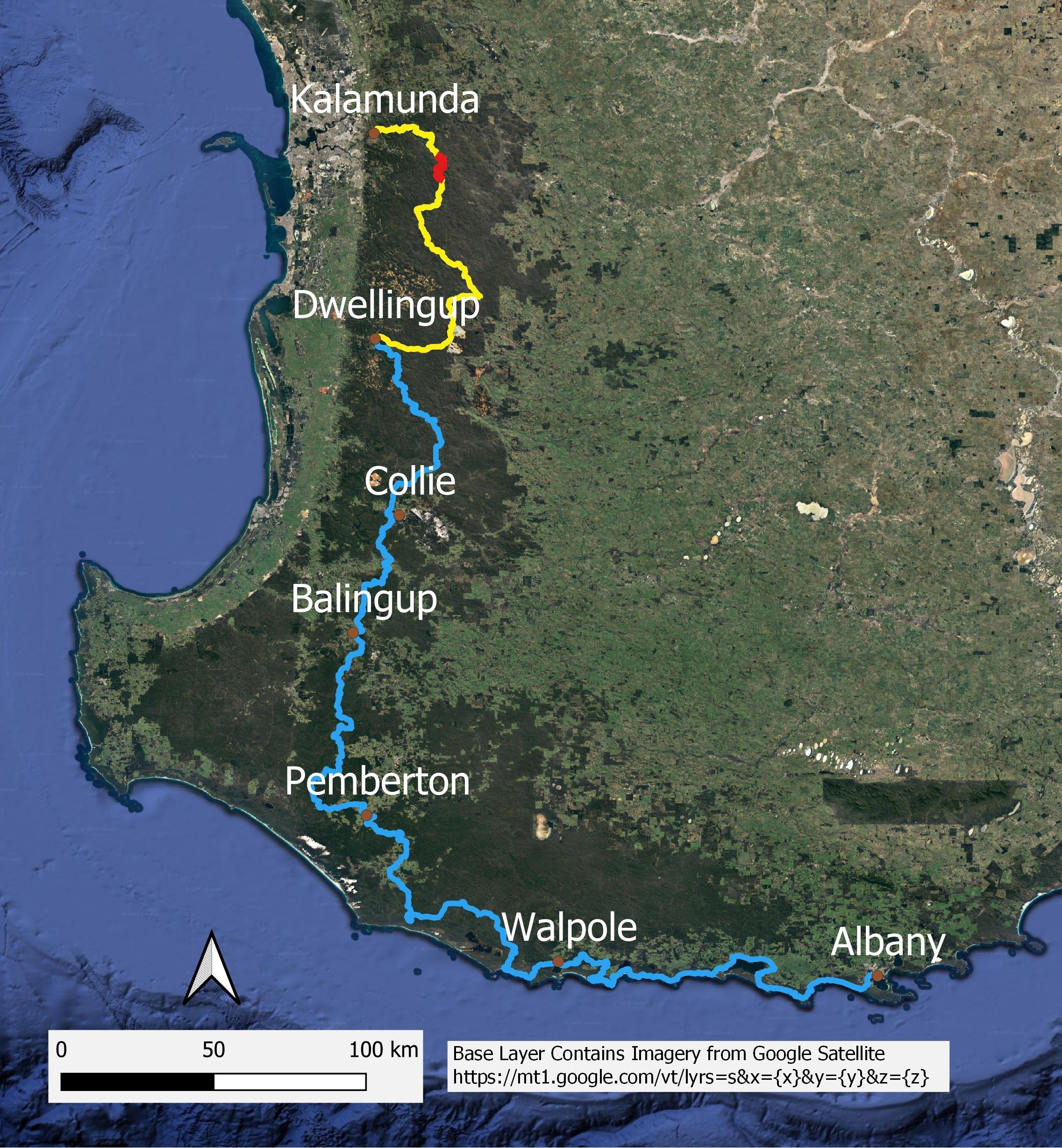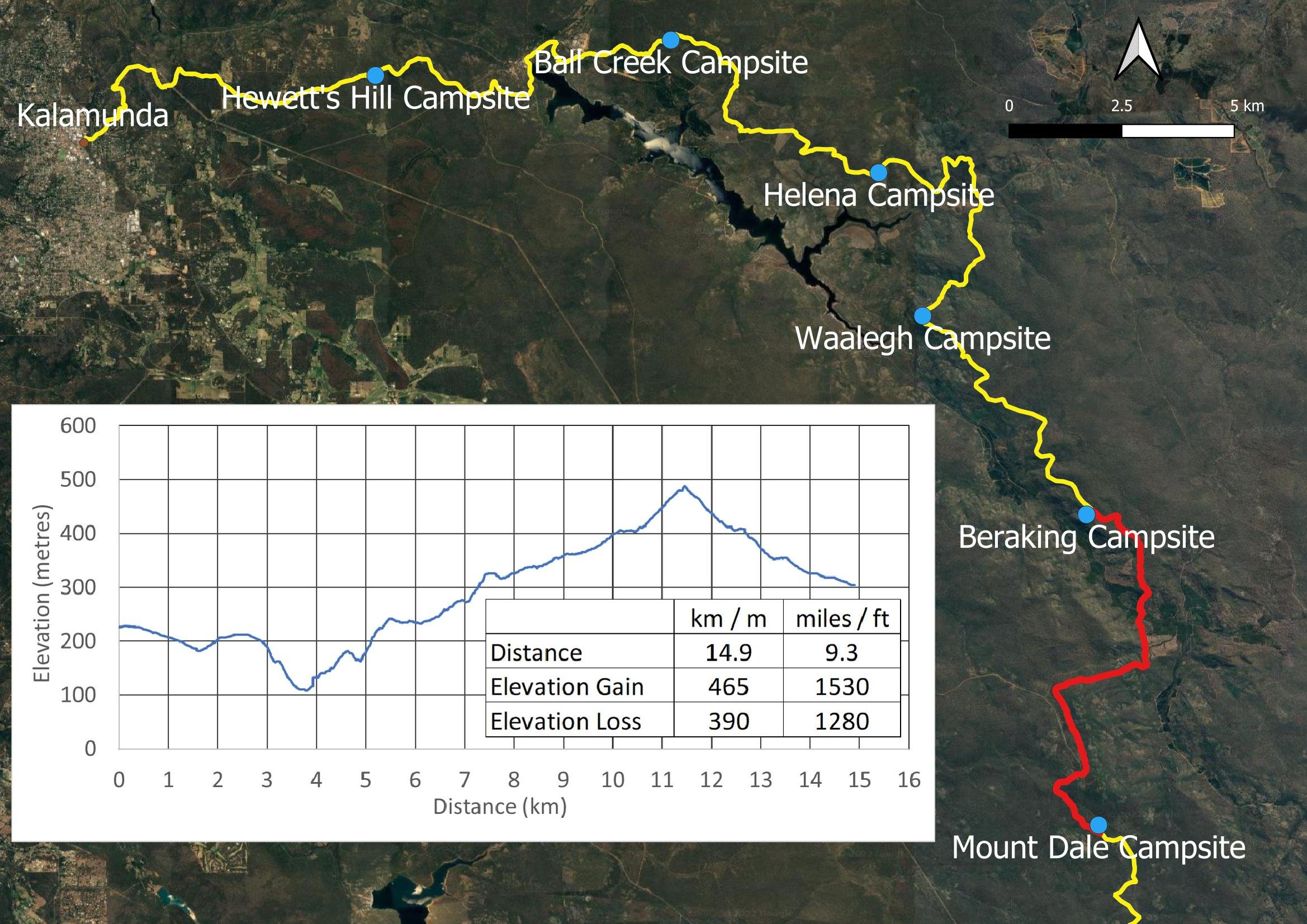Day 6: Beraking to Mt Dale
We acknowledge the Nyoongar People as the traditional custodians of the land and waters along the Bibbulmun Track
Our campsite at Mt Dale… amongst the kingia trees
I was a little apprehensive about today’s steady sustained climb, but was pleasantly surprised. The distance is perfect for slower hikers, especially if you’ve been doing one hut at a time, the surfaces are excellent – particularly later with firm smooth sand – and the grades are even rather than undulating little ups and downs. However, the spur climb to Mt Dale would have been tough if we’d tried to squeeze it in yesterday.
Botanists will be excited by the first glimpses of Western Australia’s famous white acidic sands and the corresponding change in vegetation. We also saw many birds through this section, including red tailed black cockatoos, and the vistas from Mt Dale are expansive. Today is an absolute treat.
Inching our way south! Use the Bibbulmun Track Foundation Map 1 The Darling Range
The days details - 14.9 km with a solid elevation gain of 465 m including our side trip to the summit and its pretty much all in one hit - but the grade is not too steep.
Forestry tracks are so small and deserted we enjoy them as much as single track. It is much less tiring than rocky single track where you need to watch every step.
The weather is promising: sunny but not hot, perfect for walking.
Zamia (Macrozamia riedleyi) is a striking member of the ancient cycad family. This is one genus we don’t have in South Australia and it is wonderful seeing this stunning palm-like plant in otherwise familiar dry sclerophyll forest.
Xanthorrhoea, Zamia, Dryandra - overseas visitors will be gobsmacked. Hell, I am too!
Drosera macrantha
As well as the flowers and pods, the leaves are astonishing. In this tough environment, they’ve developed all kinds of ways to prevent grazing and dessication. Here, Daviesia decurrens with bright orange seed pods.
Reed Trigger Plant, Stylidium junceum
Drumstick Isopogon (I. sphaerocephalus). Flowers are arranged in a classic Fibonacci spiral.
You can see why they’re called drumsticks!
And a new Donkey orchid! Diuris magnifica, the Pansy orchid. Of course I don’t know its name today, only that it looks different.
These are not Xanthorrhoea, but a completely different single-species genus, Kingia. The flower spikes are like drumsticks rather than long spikes, and some of the crowns are three metres tall. Spectacular!
Acacia and Trymalium sp under the smooth white trunks of wandoo.
Purple coneflower (Isopogon formosus).
We hide our packs behind a tree at the spur road to Mt Dale summit. The track has recently been re-routed so you’ll veer off to the left (if traveling south) and enjoy a pleasant loop on single track rather than an out-and-return up a spur road. Nicely done, Bibbulmun Foundation! Quite a few cars pass us. This picture doesn’t do justice to the view. There is forest as far as the eye can see, with just one small logged area. It’s quite deceptive, really, and part of the Bibbulmun sleight of hand: nearly all of this area is riddled with forestry tracks, but you can’t see them. It is the illusion of wilderness, rather than wilderness.
On our return down and past a granite outcrop, we saw this rather sad and finished Prasophyllum parvifolium, the Autumn Leek Orchid.
Mt Dale Hut, with a crackling fire, genial company and, later, an inquisitive bandicoot. You can see our stuff on the outdoor table with tea on the boil!
The campsites are fantastic amongst the Kingias. Where else could you camp amongst Kingias? I tell you where: nowhere on earth!
A couple of daggy old farts having dinner by the campfire. I’ve had a wonderful day, and am beginning to think I might just be able to do this thing!






















